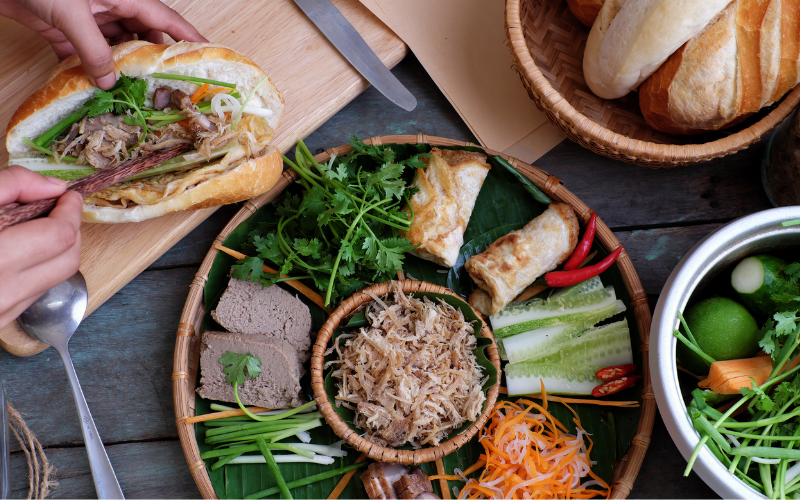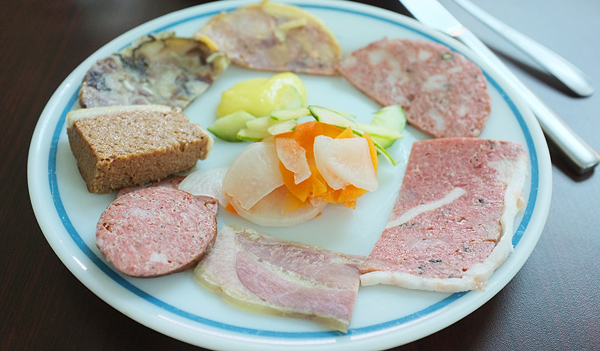In recent years, charcuterie boards have taken the culinary world by storm, becoming a popular choice for entertaining and gatherings. These visually appealing platters are typically adorned with an assortment of cured meats, cheeses, fruits, nuts, and more. But have you ever considered elevating your charcuterie experience with a delightful twist? Enter the Banh Mi Charcuterie Board – a fusion of Vietnamese and French cuisines that promises an explosion of flavors. In this article, we’ll explore this innovative take on the traditional charcuterie board, its key elements, and how you can create your own Banh Mi Charcuterie Board to impress your guests.
What is a Banh Mi Charcuterie Board?

Banh Mi, a popular Vietnamese dish, is a delectable sandwich featuring a combination of savory ingredients like grilled meats, pickled vegetables, fresh herbs, and condiments, all served within a French baguette.
The Banh Mi Charcuterie Board combines the essence of traditional charcuterie with the bold and vibrant flavors of Banh Mi, offering a unique and mouthwatering experience.
Why do they call it a charcuterie board?
The term “charcuterie board” originates from the French word “charcuterie,” which refers to the art and craft of preparing and preserving various types of cured meats and other meat products. In France, charcuterie has a long history, dating back centuries, and is considered an essential aspect of French gastronomy.
A charcuterie board is named after “charcuterie” because it typically features an assortment of cured meats and various accompaniments. The board is used to artfully display and present these savory delights, allowing guests to enjoy a variety of flavors, textures, and combinations in one visually appealing and delicious spread.
Charcuterie board rules
- Variety: Include a diverse selection of cured meats, cheeses, fruits, nuts, and accompaniments.
- Presentation: Arrange items neatly and aesthetically on the board for visual appeal.
- Balance: Aim for a balanced combination of flavors, textures, and colors.
- Freshness: Ensure all ingredients are fresh and of high quality.
- Serving Utensils: Provide appropriate utensils for serving, like cheese knives and tongs.
- Dietary Considerations: Offer options for different dietary preferences, including vegetarian or gluten-free choices.
- Spacing: Leave enough space between items to avoid overcrowding and easy access for guests.
- Temperature: Keep perishable items chilled until serving time.
- Refills: Monitor the board and replenish items as needed during the event.
Encourage guests to explore and enjoy the variety of flavors and combinations.
What goes good on a charcuterie board?
Cold Cuts Selection

To start, gather an enticing array of cold cuts that will tantalize your guests’ taste buds. Embrace the fusion concept with a variety of pork-based meats, including:
- Pork Meatloaf: A savory and moist pork meatloaf, seasoned to perfection, provides a hearty option for sandwich assembly.
- Fried Chicken Meatloaf: Add a twist with fried chicken meatloaf, offering a delightful crispy texture to contrast the other ingredients.
- Liver Pate: A rich and indulgent liver pate adds a touch of luxury to the board, appealing to those seeking an elevated experience.
- Head Cheese: Include head cheese, a cold cut made from various parts of the pig’s head, bound together in a savory jelly.
- Sausage with Ear and Snouts: For the adventurous food enthusiasts, sausages made from ear and snouts bring a unique and authentic Vietnamese touch.
Pickled Vegetables

Pickled vegetables are a must-have to balance the flavors and add a zesty kick. Prepare the following pickled delights:
- Carrots: Crispy and sweet pickled carrots offer a refreshing and vibrant element to the board.
- Daikon Radish: With its mild and peppery flavor, pickled daikon radish complements the other ingredients beautifully.
- Cucumber: Sliced and pickled cucumber enhances the overall crunchiness and adds a hint of coolness to the Banh Mi experience.
- Pickled Onions: Tangy and slightly sweet, pickled onions contribute to the medley of flavors and elevate the taste profile.
Fresh Herbs

The inclusion of fresh herbs brings brightness and aromatic complexity to the Banh Mi Charcuterie Board. Gather these essential herbs:
- Cilantro: Known for its bright and citrusy notes, cilantro enhances the overall freshness of the sandwiches.
- Mint: The cool and refreshing flavor of mint complements the meats and pickled vegetables, creating a harmonious balance.
- Vietnamese Coriander: This unique herb adds a peppery and slightly spicy kick, characteristic of Vietnamese cuisine.
Flavorful Spreads

No Banh Mi Charcuterie Board is complete without delectable spreads that elevate the taste experience. Offer the following tantalizing options:
- Vietnamese Mayonnaise: This creamy and tangy mayo brings a Vietnamese twist to the classic spread.
- Hoisin Sauce: Known for its sweet and savory profile, hoisin sauce adds depth to the sandwiches.
- Sriracha Sauce: For those who crave a bit of heat, sriracha sauce provides a spicy kick that enhances the overall flavor.
Assorted Accompaniments

To round out the foundation, present a delightful selection of accompaniments that complement the Banh Mi experience:
- Baguettes: The quintessential French baguettes serve as the canvas for crafting the Banh Mi sandwiches.
- Rice Paper Wrappers: For a unique twist, offer rice paper wrappers, allowing guests to create their own fresh spring rolls.
- Fresh Fruit: Sliced tropical fruits, such as pineapple and mango, add a touch of sweetness and juiciness to the board.
- Nuts: A medley of nuts, such as cashews and almonds, provides an additional layer of texture and flavor.
Assembling Your Banh Mi Charcuterie Board

Strategically place the meats, cheeses, pickled vegetables, herbs, and condiments in separate clusters, allowing guests to mix and match their favorite flavors.
Create an aesthetically pleasing arrangement with a balance of colors, textures, and heights, making it irresistible to the eye.
Serving and Enjoying

Encourage your guests to assemble their Banh Mi sandwiches by layering the ingredients of their choice onto the baguette slices or crackers.
Suggest beverage pairings such as Vietnamese iced coffee, craft beer, or a crisp white wine to complement the bold flavors of the Banh Mi Charcuterie Board.
FAQs
Can I make a vegetarian version of the Banh Mi Charcuterie Board?
Absolutely! You can substitute the meats with grilled tofu, marinated tempeh, and additional plant-based toppings.
How long can I prepare the Banh Mi Charcuterie Board in advance?
It’s best to assemble the board shortly before serving to ensure the ingredients stay fresh and vibrant.
Can I add other Vietnamese dishes to the charcuterie board?
Certainly! Consider adding spring rolls, Vietnamese rice paper rolls, or even Banh Mi-inspired sliders for variety.
What other bread options can I offer on the board?
Alongside the traditional French baguette, you can include mini croissants, sliced bread rolls, or gluten-free baguettes.
How do I store leftover ingredients after the event?
Store leftover ingredients in airtight containers in the refrigerator and use them for other dishes or sandwiches within a day or two.
How to wrap charcuterie board?
To wrap a charcuterie board for transportation:
- Arrange all items neatly on the board.
- Optionally, use aluminum foil for delicate items.
- Cover the board with cling wrap or plastic wrap.
- Secure the wrap with rubber bands or twine.
- Refrigerate if not transporting immediately.
- Handle with care during transportation.
- Unwrap and serve when ready.
What type of board is used for charcuterie board?
Charcuterie boards can be made from various materials, each offering unique aesthetics and functionality. Here are some common types of boards used for charcuterie presentations:
- Wooden Boards: Wooden boards are a classic and popular choice for charcuterie boards. They come in various shapes and sizes and can be made from different types of wood, such as bamboo, acacia, or maple. Wooden boards provide a rustic and natural look, which complements the assortment of meats and cheeses.
- Marble or Stone Boards: Marble or stone boards offer an elegant and sophisticated presentation for charcuterie. They have a smooth and cool surface that can help maintain the freshness of the ingredients, especially in warmer environments.
- Slate Boards: Slate boards are sleek and modern, providing an excellent contrast for the colorful and varied charcuterie items. They are easy to clean and provide a contemporary touch to the presentation.
- Acrylic or Glass Boards: Acrylic or glass boards provide a sleek and minimalist look. They allow the focus to be on the vibrant colors and textures of the charcuterie items and are easy to clean.
- Ceramic or Porcelain Boards: Ceramic or porcelain boards can add a touch of elegance and creativity to the presentation. They often come in intricate designs and patterns, making the charcuterie board a centerpiece for any gathering.
- Elevated Boards or Lazy Susans: Some charcuterie boards come with built-in stands or rotating bases, making it easy for guests to access and enjoy the variety of items from all sides. These are especially useful for larger gatherings.
Conclusion
The Banh Mi Charcuterie Board is a delightful culinary journey that combines the best of Vietnamese and French cuisines. By integrating the diverse flavors, textures, and visual appeal, this innovative twist on the traditional charcuterie board promises to leave your guests impressed and satisfied. Whether you’re hosting a casual get-together or a special occasion, the Banh Mi Charcuterie Board is sure to be a showstopper, celebrating the harmony of two culinary worlds.